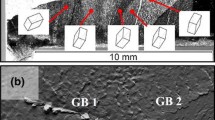Abstract
Isothermal aging causes degradation in the mechanical behavior of lead-free solder materials used in microelectronic packaging, leading to significant reductions in product reliability. In this work, we have characterized the aging-induced changes that occur in the mechanical properties and creep behavior of actual solder joints. These changes occur due to microstructure evolution and residual strains/stresses in the solder material, and measurement of these evolutions are critical to developing a fundamental understanding of solder aging phenomena. The enhanced high-energy X-ray microdiffraction beamline present at the synchrotron at the Advanced Light Source at Lawrence Berkeley National Laboratory was employed to characterize the solder joints after various aging times at 125 °C. Aging-induced changes in the Sn grain orientation, Sn grain distribution, and residual strain distribution were measured. The observed microstructural evolution was then correlated with changes in the mechanical response of the solder joints measured using nanoindentation.













Similar content being viewed by others
References
H. Ma, J.C. Suhling, A review of mechanical properties of lead-free solders for electronic packaging. J. Mater. Sci. 44, 1141–1158 (2009)
H. Ma, J.C. Suhling, P. Lall, M.J. Bozack, Reliability of the aging lead-free solder joint, in Proceedings of the 56th Electronic Components and Technology Conference (2006), pp. 849–864
Y. Zhang, Z. Cai, J.C. Suhling, P. Lall, M.J. Bozack, The effects of aging temperature on SAC solder joint material behavior and reliability, in Proceedings of the 58th IEEE Electronic Components and Technology Conference (2008), pp. 99–112
M. Mustafa, Z. Cai, J.C. Suhling, P. Lall, The effects of aging on the cyclic stress-strain behavior and hysteresis loop evolution of lead free solders, in Proceedings of the 61st Electronic Components and Technology Conference (2011), pp. 927–939
J. Zhang, Z. Hai, S. Thirugnanasambandam, J.L. Evans, M.J. Bozack, Y. Zhang, J.C. Suhling, Thermal aging effects on thermal cycling reliability of lead-free fine pitch packages. IEEE Trans. Compon. Packag. Technol. 3(8), 1348–1357 (2013)
M. Hasnine, J. Suhling, B.C. Prorok, M.J. Bozack, P. Lall, Exploration of aging induced evolution of solder joints using nanoindentation and microdiffraction, in Proceedings of the 64th Electronic Components and Technology Conference (2014), pp. 379–394
M. Hasnine, M. Mustafa, J.C. Suhling, B.C. Prorok, M.J. Bozack, P. Lall, Characterization of aging effects in lead free solder joints using nanoindentation, in Proceedings of the 63rd IEEE Electronic Components and Technology Conference (2013), pp. 166–178
J.H.L. Pang, T.H. Low, B.S. Xiong, X. Luhua, C.C. Neo, Thermal cycling aging effects on Sn–Ag–Cu solder joint microstructure, IMC and strength. Thin Solid Films 462–463, 370–375 (2004)
R. Darveaux, Shear deformation of lead free solder joints, in Proceedings of the 55th IEEE Electronic Components and Technology Conference (2005) pp. 882–893
S. Wiese, K.J. Wolter, Creep of thermally aged Sn–Ag–Cu solder joints. Microelectron. Reliab. 47, 223–232 (2007)
I. Dutta, D. Pan, R.A. Marks, S.G. Jadhav, Effect of thermo-mechanically induced microstructural coarsening on the evolution of creep response of SnAg-based microelectronic solders. Mater. Sci. Eng. A 410–411, 48–52 (2005)
M. Kunz, N. Tamura, K. Chen, A.A. Macdowell, E. Ustundag, A dedicated superband X-ray microdiffraction beamline for materials, geo-, and environmental sciences at the advanced light source. Rev. Sci. Instr. 80, 035108 (2009)
A.T. Wu, N. Tamura, J.R. Lloyd, C.R. Kao, K.N. Tu, Synchrotron X-ray microdiffraction analysis on microstructure evolution in Sn under electromigration. Mater. Res. Soc. Symp. Proc. 863, B9 (2005)
K. Chen, N. Tamura, B.C. Valek, K.N. Tu, Plastic deformation in Al(Cu) interconnects stressed by electromigration and studied by synchrotron polychromatic X-ray microdiffraction. J. Appl. Phys. 104, 013513 (2008)
P. Sarobol, W.H. Chen, Effects of local grain misorientation and β-tin elastic anisotropy on whisker and hillock formation. J. Mater. Res. 28(5), 747–756 (2013)
P. Sarobol, J.P. Koppes, W.H. Chen, P. Su, J.E. Blendell, C.A. Handwerker, Recrystallization as a nucleation mechanism for whiskers and hillocks on thermally cycled Sn-alloy solder films. Mater. Lett. 99, 76–80 (2013)
G. Henshall, iNEMI lead-free alloy alternatives project report: thermal fatigue experiments and alloy test requirements, in Proceedings of the SMTAI (2009), pp. 317–324
W.C. Oliver, G.M. Pharr, An improved technique for determining hardness and elastic modulus using load and displacement sensing indentation experiments. J. Mater. Res. 7(6), 1564–1583 (1992)
J. Hay, P. Agee, E. Herbert, Continuous stiffness measurement during instrumented indentation testing. experimental techniques. 34(3), 86–94 (2010)
W.V. Green, P.P. Gillis, E.G. Zukas, Subgrain boundary changes caused by creep deformation. Acta Metall. 18(1), 43–52 (1970)
H. Chen, J. Han, M. Li, Localized recrystallization induced by subgrain rotation in Sn-3.0 Ag-0.5 Cu ball grid array solder interconnects during thermal cycling. J. Electron. Mater. 40(12), 2470–2479 (2011)
R. Sedláček, W. Blum, J. Kratochvil, S. Forest, Subgrain formation during deformation: physical origin and consequences. Metall. Mat. Trans. A 33(2), 319–327 (2002)
H.J. Frost, M.F. Ashby, Deformation Mechanism Maps: The Plasticity and Creep of Metals and Ceramics (Pergamon Press, Oxford, 1982)
Acknowledgements
This work was supported by the NSF Center for Advanced Vehicle Electronics and Extreme Environment (CAVE3). We thank the members of iNEMI for providing the joint samples tested in this work. We also gratefully acknowledge and thank Dr. Nobumichi Tamura and Dr. Martin Kunz for assistance with the microdiffraction measurements and data extraction, and for valuable discussions. We acknowledge a grant from the DOE for access to beamline 12.3.2 of the Advanced Light Source (ALS), which is supported by the Office of Basic Energy Science, Material Science Division, of the U.S. Department of Energy under Contact DE-AC02-05Ch11231 at Lawrence Berkeley National Laboratory.
Author information
Authors and Affiliations
Corresponding author
Rights and permissions
About this article
Cite this article
Hasnine, M., Suhling, J.C. & Bozack, M.J. Effects of high temperature aging on the microstructural evolution and mechanical behavior of SAC305 solder joints using synchrotron X-ray microdiffraction and nanoindentation. J Mater Sci: Mater Electron 28, 13496–13506 (2017). https://doi.org/10.1007/s10854-017-7189-7
Received:
Accepted:
Published:
Issue Date:
DOI: https://doi.org/10.1007/s10854-017-7189-7




